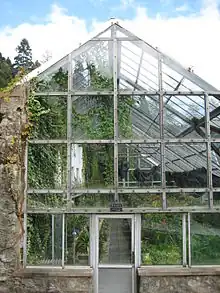Lushan Botanical Garden
Lushan Botanical Garden, Chinese Academy of Sciences,[1] is a botanical garden located within Mount Lu, Jiujiang, People's Republic of China. It is the first subtropical mountain botanical garden in China. Founded on August 20, 1934, it was originally called Lushan Forest Botanical Garden and was founded by Hu Xiansu, Ren-Chang Ching, and Chen Fenghuai. Since its founding, its affiliation and name has gone through several changes. Currently, it is under the administration of the Chinese Academy of Sciences and is composed of 13 special parks with over 5,000 species of plants, along with 170,000 specimens and 3400 plant taxa.[1][2][3]

Lushan Botanical Garden is famous for its gymnosperm collection, which had been introduced from 15 countries. There are more than 200 species of Gymnosperms from 11 families and 41 genera within its Pinales special park.[4]
Lushan Botanical Garden is a member of Botanic Gardens Conservation International (BGCI) and the Initiative for Collective Conservation in Chinese Botanical Gardens (ICCBG).[5]
The botanical garden currently hosts 140 staff, including 43 doctors and 40 masters, being mainly from Nanchang University, along with 800,000 tourists annually.[5]
It is also the location of the tomb of Chen Yinke and the "Tomb of the Three Elders" (Hu Xiansu, Ren-Chang Ching, and Chen Fenghuai), both of which are protected cultural relics.
References
- "中国科学院庐山植物园". www.lsbg.cn. Retrieved 2023-02-03.
- Zhang, Qingsong (2007-05-09). "The Development of Lushan Botanical Garden" (PDF). Botanic Gardens Conservation International. Retrieved 2023-04-09.
- "Lushan Botanical Garden". www.gbif.org. Retrieved 2023-04-10.
- Wang, Guoquan; 汪国权. (2004). Lushan lü you quan shu. Mao Su, Chun Fang, 苏茂., 方淳. (Di 1 ban ed.). Nanchang Shi: Jiangxi mei shu chu ban she. ISBN 978-7-80690-400-8. OCLC 189419379.
- "庐园简介_中国科学院庐山植物园". www.lsbg.cn. Retrieved 2023-04-09.